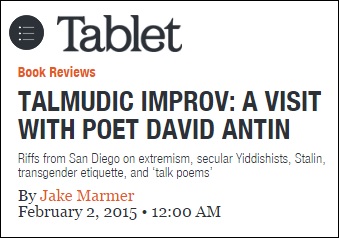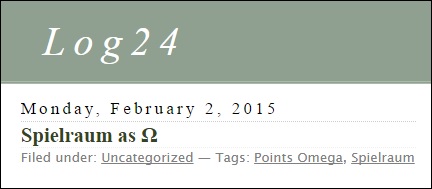Click the chessboard for some Chinese hermeneutics.
Thursday, September 9, 2021
Enlarging the Spielraum… Continues.
Wednesday, August 11, 2021
Expanding the Ulysses Spielraum
For Stephen King and the Club Dumas —
Related perceptive remarks by Juliane Ungänz —
Zweig was the author of Schachnovelle .
Thursday, April 4, 2019
Expanding the Spielraum . . .
Saturday, June 3, 2017
Expanding the Spielraum (Continued*)
Or: The Square
"What we do may be small, but it has
a certain character of permanence."
— G. H. Hardy
* See Expanding the Spielraum in this journal.
Wednesday, April 12, 2017
Contracting the Spielraum
The contraction of the title is from group actions on
the ninefold square (with the center subsquare fixed)
to group actions on the eightfold cube.
From a post of June 4, 2014 …
At math.stackexchange.com on March 1-12, 2013:
“Is there a geometric realization of the Quaternion group?” —

The above illustration, though neatly drawn, appeared under the
cloak of anonymity. No source was given for the illustrated group actions.
Possibly they stem from my Log24 posts or notes such as the Jan. 4, 2012,
note on quaternion actions at finitegeometry.org/sc (hence ultimately
from my note “GL(2,3) actions on a cube” of April 5, 1985).
Expanding the Spielraum
"Cézanne ignores the laws of classical perspective . . . ."
— Voorhies, James. “Paul Cézanne (1839–1906).”
In Heilbrunn Timeline of Art History . New York:
The Metropolitan Museum of Art, 2000–. (October 2004)
Some others do not.
This is what I called "the large Desargues configuration"
in posts of April 2013 and later.
Sunday, December 11, 2016
Expanding the Spielraum
Tony Stark's "little gray area" remark to Peter Parker
in the previous post suggests an elementary calculation:

Compare to a remark from Wikipedia:

"This is the total area of
the 88 modern constellations
in the sky."
— Wikipedia, Square degree
Wednesday, June 15, 2016
Expanding the Spielraum …

"My AMS invited address at the SIAM Annual Meeting July 11–15
in Boston discusses the extension of eigenvectors and singular
vectors from matrices to higher order tensors."
— Bernd Sturmfels in the June-July 2016 AMS Notices
See also Sturmfels in this journal — for instance, in
"Expanding the Spielraum," a post of Feb. 3, 2015 —
Thursday, May 26, 2016
Expanding the Spielraum
The physicist Hendrik van Dam was mentioned in recent posts.
He reportedly died at 78 on February 11, 2013.
A post from that date, and a followup —
Monday, October 26, 2015
Expanding the Seagram Spielraum
From the previous post, Expanding the Spielraum —
"The knights and squires of nearby Ambras used to let their
steeds romp here, whence came the name Tummelplatz ."
— Quelle: Ludwig von Hörmann, "Der Tummelplatz bei Amras,"
in: Der Alpenfreund , 1. Band, Gera 1870, S. 72 – 73.

Expanding the Spielraum
Halloween meditation on the Tummelplatz at Innsbruck —
"Die Ritter und Knappen des nahegelegenen Ambras
pflegten hier ihre Rosse zu tummeln, woher sich auch
der Name Tummelplatz schreibt."
"The knights and squires of nearby Ambras used to let their
steeds romp here, whence came the name Tummelplatz ."
— Quelle: Ludwig von Hörmann, "Der Tummelplatz bei Amras,"
in: Der Alpenfreund , 1. Band, Gera 1870, S. 72 – 73.
See as well Sigmund Freud, Erinnern, Wiederholen und Durcharbeiten
(1914) —
"Wir eröffnen ihm die Übertragung als den Tummelplatz ,
auf dem ihm gestattet wird, sich in fast völliger Freiheit
zu entfalten, und auferlegt ist, uns alles vorzuführen,
was sich an pathogenen Trieben im Seelenleben des
Analysierten verborgen hat."
"We admit it into the transference as a playground
in which it is allowed to expand in almost complete freedom
and in which it is expected to display to us everything in the
way of pathogenic instincts that is hidden in the patient's mind."
This passage has been discussed by later psychotherapists,
notably Russell Meares. Dr. Meares, working from a translation
that has "playground" for Freud's Tummelplatz , uses Spielraum
in place of Freud's own word.


For related material in this journal, see Expanding the Spielraum.
An illustration from that search —
Thursday, July 2, 2015
Deepening the Spielraum
(A sequel to Expanding the Spielraum (Feb. 3, 2015))
"Knowledge, wisdom even, lies in depth, not extension."
— Tim Parks in The New York Review of Books ,
5 PM ET on June 26, 2015
See also Log24 posts on the following figure —
Thursday, June 18, 2015
Friday, May 8, 2015
Spielraum
Review:
Illustrating the Spiegel-Spiel des Gevierts
|
"At the point of convergence
by Octavio Paz, translated by |
Friday December 5, 2008
|
Saturday, April 18, 2015
Expanding the Spielraum
See also today's previous post and the new film "Beyond the Reach,"
filmed in northwest New Mexico —
Friday, February 6, 2015
The Annotated Spielraum
Comments on two sub-images from yesterday's
The Big Spielraum (image, 1 MB) that may or
may not interest Emma Watson —
The Potter Sub-Image
This is from a link in a July 8, 2011, post:
The above "Childhood's End" link leads to
a midrash on the Harry Potter series:
"After pg. 759 in Harry Potter and the
Deathly Hallows , my childhood ended."
The Carmichael Sub-Image
The number of the last page in the last Harry Potter
book is 759. This number may, for those with
cabalistic tendencies, be interpreted as the
number 3*23*11 from a 1931 mathematics paper:
Thursday, February 5, 2015
The Big Spielraum
From the Office for the Arts at Harvard:
|
College Events Board
Location: Sanders Theatre, Memorial Hall,
On Sale Date: 1/29/2015 Thursday 2/5 08:00 PM
Ticket Prices: Free. Harvard ID only. Ticket Availability: Good The Harvard College Events Board presents Harvard Thinks Big VI, a night of big ideas and thinking beyond traditional boundaries. On Thursday February 5th at 8 pm in Sanders Theatre, 7 Harvard professors and lecturers will speak for ten minutes each to discuss a topic that intrigues and excites them. This annual event was first started in order to introduce the Harvard community to the fascinating research and developments from some of the greatest minds on campus. |
See as well The Big Spielraum (1 MB).
Tuesday, February 3, 2015
Expanding the Spielraum
A short poem by several authors:
"The role of
the 16 singular points
on the Kummer surface
is now played by
the 64 singular points
on the Kummer threefold."
— From Remark 2.4 on page 9 of
"The Universal Kummer Threefold,"
by Qingchun Ren, Steven V Sam,
Gus Schrader, and Bernd Sturmfels,
http://arxiv.org/abs/1208.1229v3,
August 6, 2012 — June 12, 2013.
See also "Expanded Field" in this journal.
Illustration from "Sunday School," July 20, 2014.
Monday, February 2, 2015
Spielraum as Ω
|
From "Origins of the Logical Theory of Probability: von Kries, Wittgenstein, Waismann," by Michael Heidelberger — "Von Kries calls a range of objective possibilities of a hypothesis or event (under given laws) its Spielraum (literally: play space), which can mean ‘room to move’, ‘leeway’, ‘latitude of choice’, ‘degree of freedom’ or ‘free play’ and ‘clearance’ – or even ‘scope’. John Maynard Keynes translated it as ‘field’, but the term ‘range’ has generally been adopted in English. Von Kries now holds that if numerical probability were to make any sense at all it must be through this concept of the Spielraum . Von Kries’s theory is therefore called a ‘Spielraum theory’ or ‘range theory of probability’." — International Studies in the Philosophy of Science , Volume 15, Issue 2, 2001, pp. 177-188 |
See also the tag Points Omega.
(Scroll down to January 11-12, 2015.)
Related material:
"Now, for example, in how far are
the six sides of a symmetric die
'equally possible' upon throwing?"
— From "The Natural-Range Conception
of Probability," by Dr. Jacob Rosenthal,
page 73 in Time, Chance, and
Reduction: Philosophical Aspects of
Statistical Mechanics , ed. by
Gerhard Ernst and Andreas Hüttemann,
Cambridge U. Press, 2010, pp. 71-90
Sunday, February 1, 2015
Spielraum III
Saturday, January 31, 2015
Spielraum
From the concluding paragraph of a new book by
mathematician Michael Harris:
"A team of eminent scholars is completing a definitive
edition of Hausdorff’s collected works—'unique …
in the annals of mathematical publishing'— with the
care befitting the literary figure he undoubtedly was….
… he is honored as, perhaps, the first modern
mathematician to give a name to what we have been
calling the 'relaxed field'— he called it the
'Spielraum of thought'— and as a mathematician
who never lost his sensitivity to his chosen field’s
problematic attractions while remaining fully aware that
every veil lifted only reveals another veil."
— Harris, Michael, Mathematics without Apologies:
Portrait of a Problematic Vocation (2015-01-18)
(pp. 324-325). Princeton U. Press. Kindle Edition.
Related material: Spiel ist nicht Spielerei .
Friday, February 3, 2023
Expansive Sensibilities
See as well Expanding the Spielraum.
Saturday, April 30, 2022
Sunday, September 5, 2021
“They All Laughed at Christopher Columbus . . .”
Q Tip . . . *
Monday, August 16, 2021
The Space of Possibilities
The title is from "Federico Ardila on Math, Music and
the Space of Possibilities," a podcast from Steven Strogatz's
Quanta Magazine series. The transcript is dated March 29, 2021.
Ardila: … in a nutshell, what combinatorics is about is just
the study of possibilities and how do you organize them,
given that there’s too many of them to list them.
Strogatz: So, I love it. Combinatorics is not just
the art of the possible, but the enumeration of the possible,
the counting of the possible and the organizing of the possible.
Strogatz: It’s such a poetic image, actually: the space of possibilities.
This journal on the podcast date, March 29, 2021 —
A more precise approach to the space of possibilities:
Wednesday, August 11, 2021
Synchronology Check
From the previous post . . .
"This review was filed from the 2020 Sundance Film Festival
on January 30th."
Meanwhile . . .
Click the above image for posts on "Expanding the Spielraum."
See as well . . .

Thursday, October 29, 2020
The Art of the Possible: Weyl as Magister Ludi ?
Johann A. Makowsky recently reviewed Modernism, Fiction and Mathematics
by Nina Engelhardt. Engelhardt is a Wissenschaftliche Mitarbeiterin at the
University of Stuttgart. Makowsky is a professor emeritus of the computer science
department at the Technion-Israel Institute of Technology …
The quotation below, by Makowsky not Engelhardt, is from Notices of the
American Mathematical Society , November 2020 (Vol. 67, No. 10, p. 1594) —
"Hermann Weyl was known for his inspiring lectures,
celebrating mathematics as a performing art. It is then likely
that he was both the model for the magister ludi celebrating
the Glass Bead Game, and the source of Hesse’s awareness of
modern mathematics as the art of the possible, rather than
the science of true nature."
Possibly .
Consider also the diamond as Spielraum .
Monday, October 26, 2020
Theory

These news items suggest a review —
The above “Pynchon’s Paranoid History” page number appeared
in this journal on Groundhog Day, 2015 —
David Justice on a Zeta-related theory —
Friday, September 4, 2020
Force Field of Dreams
(Continued from September 22, 2002.)
“As you read, watch for patterns. Pay special attention to
imagery that is geometric….” — “Pattern in The Defense “


See as well Wednesday’s Smile, and “Expanding the Spielraum“ .
Monday, March 16, 2020
Mathematics and Narrative* Continues:
Mathematics: See Tetrahedron vs. Square in this journal
(Notes on two different models of schoolgirl space ).
Narrative: Replacing the square from the above posts by
a related cube …
… yields a merchandising inspiration —
Dueling Holocrons:
Jedi Cube vs. Sith Tetrahedron —
* See also earlier posts on Mathematics and Narrative.
Thursday, January 30, 2020
Poster Boy

Cover Design: Will Staehle / Unusual Co.
This post is in memory of "Wes Wilson, Psychedelic Poster Pioneer,"
who died at 82 on January 24, according to the NY Times today.
Related material — This journal on January 24.
Friday, April 5, 2019
A Definite Field
"We render the compulsion harmless, and indeed useful,
by giving it the right to assert itself in a definite field.
We admit it into the transference as a playground…."
— Sigmund Freud, 1914, "Remembering, Repeating,
and Working-Through" (See "Expanding the Spielraum,"
Oct. 26, 2015, in this journal.)
An indefinite field —

A definite field —
Monday, October 22, 2018
Story Space
Thursday, August 24, 2017
Maori Chess
![]()
The Decepticons date above, June 21, 2017, suggests an instance of
that date in this journal —
For the Church of Synchronology, a New York Times item from
the above death date, June 21, 2017 —
See as well Kurt Russell in Guardians of the Galaxy, Vol. 2 —
Some relevant context: Expanding the Spielraum .
Wednesday, August 9, 2017
Implosion
Sunday, June 4, 2017
Sequel to “The Square”* —
The Cube
CodePen logo, pictured here on May 28, 2017 —
From YouTube, "The Cube," published on April 6, 2016 —
Meanwhile, also on April 6, 2016, at 2:01 AM ET …
* See The Pinterest Directive and Expanding the Spielraum.
Thursday, April 20, 2017
Point 8777*
Or: Expanding the Spielraum, continued
Wikipedia on author Michael Connelly —
Connelly had planned on following his father’s early choice of
career in building construction and started out at the
University of Florida in Gainesville as a building construction major.
After earning grades that were lower than expected, Connelly went
to see Robert Altman’s film The Long Goodbye (1973) and was
enchanted by what he saw. The film, based on Raymond Chandler’s
1953 novel of the same name, inspired Connelly to want to become
a mystery writer. Connelly went home and read all of Chandler's
works featuring Philip Marlowe, a detective in Los Angeles during
the 1940s and ‘50s, and decided to switch majors to journalism with
a minor in creative writing.[4] He was a student of Harry Crews.
[See also …
https://blogs.wsj.com/speakeasy/2012/11/24/
the-teacher-michael-connelly-never-forgot/.]
A 2002 novel by Connelly — City of Bones .
Two scenes from a 2014 TV pilot based on the 2002 novel —


The "Bosch" pilot does not state the address, but its location in the
Hollywood Hills suggests a review of Heinlein Lottery in this journal.
"Bonedigger Bonedigger
Dogs in the moonlight"
— Paul Simon
* Title suggested by that of the previous post, "Point Zero."
Sunday, December 11, 2016
Stark to Parker in New Trailer
"Don't do anything I would do.
And definitely don't do anything I wouldn't do.
There's a little gray area in there
and that's where you operate."
See as well "Spirit and Space" (Nov. 25, 2016) —
Monday, October 17, 2016
Groundhog Day Tablet
This journal on that date —
The Los Angeles Times this morning reported that poet
David Antin died at 84 last Tuesday, October 11.
From this journal on that date —
Friday, June 3, 2016
Bruins and van Dam
A review of some recent posts on Dirac and geometry,
each of which mentions the late physicist Hendrik van Dam:
- Kummer and Dirac (May 25)
- Framework (May 25)
- Expanding the Spielraum (May 26)
- Dorje (May 26)
The first of these posts mentions the work of E. M. Bruins.
Some earlier posts that cite Bruins:
- Anticommuting Dirac Matrices as Skew Lines (Nov. 20, 2015)
- Dirac and Line Geometry (Nov. 23, 2015)
- Einstein and Geometry (Nov. 27, 2015)
Sunday, November 1, 2015
Transitions
Two transitions from last Monday, Oct. 26, 2015,
according to the online New York Times today —
|
Leo P. Kadanoff, a physicist who provided critical insights into the transformations of matter from one state to another, died last Monday in Chicago. He was 78. The cause was respiratory failure, said the University of Chicago, where he was a professor from 1978 until his retirement in 2003. A member of the National Academy of Sciences and a fellow of the American Academy of Arts and Sciences, he received the National Medal of Science in 1999. “He won basically every prize except the Nobel Prize, and many people thought he should have won the Nobel,” said Emil Martinec, a physics professor at the University of Chicago who directs the university’s Kadanoff Center for Theoretical Physics. Dr. Kadanoff’s biggest scientific contribution came in the 1960s as scientists were trying to understand phase transitions, when matter changes from one form to another. A Cornell chemist, Benjamin Widom, had come up with mathematical relationships that described behavior associated with second-order phase transitions, which include the boiling of water to steam at a particular temperature and pressure. But Dr. Widom did not have an underlying physical explanation for why these relationships existed. |
Willis Carto, a reclusive behind-the-scenes wizard of the far-right fringe of American politics who used lobbying and publishing to denigrate Jews and other minorities and galvanize the movement to deny the Holocaust, died last Monday at his home in Virginia. He was 89. His death was announced by The American Free Press, a newspaper he helped found. Mr. Carto raised funds to finance a right-wing military dictatorship in the United States, campaigned to persuade blacks to voluntarily return to Africa and, most influentially, started newsletters, a journal and conferences of academics and others to deny the scale, and even the existence, of the Holocaust. The Anti-Defamation League called him “one of the most influential American anti-Semitic propagandists” and “the mastermind of the hate network.” His associates included neo-Nazis, Christian vigilantes, John Birch Society members and Ku Klux Klansmen, and his extreme views alienated mainstream conservatives. After William F. Buckley sued Mr. Carto for libel and won in 1985, Mr. Buckley said Mr. Carto epitomized “the fever swamps of the crazed right.’’ |
Related remarks:
Posts tagged "Steam," the post "On Ice-Breaking" from Oct. 27,
the post "Expanding the Seagram Spielraum" from Oct. 26, and
a 2008 article on the subject of the obituary at right above.
Thursday, April 30, 2015
Saturday, February 28, 2015
Elegy with Stars
This evening's New York Times —
"William Thomas McKinley, a prolific American composer
whose music was infused with the jazz he had performed
since childhood, died on Feb. 3 at his home in Reading,
Mass. He was 76.
He died in his sleep, his son Elliott said."
"William Thomas McKinley: Elegy for Strings (2006)
[Elliott McKinley]
137 views as of 9:45 PM ET Feb. 28, 2015
Published on Feb 11, 2015
Composed as an elegy and tribute for friends and family
that have passed, spurred by the passing of McKinley's
long time friend, drummer Roger Ryan. The performance
heard here is by the Seattle Symphony under the direction
of Gerard Schwarz.
Photos by Elliott McKinley (Rho Ophiuchi nebula complex…
and the Pleiades…) shot at Cherry Springs State Park."
Related material from the date of McKinley's death —
Expanding the Spielraum.
Saturday, February 14, 2015
Valentine Dance
Monday, February 9, 2015
Overarching Symmetry
Continued from earlier posts.
|
The Washington Post online yesterday: "Val Logsdon Fitch, the Nebraska rancher’s son who shared the Nobel Prize for detecting a breakdown in the overarching symmetry of physical laws, thus helping explain how the universe evolved after the Big Bang, died Feb. 5 in Princeton, N.J. He was 91. His death was confirmed by Princeton University, where he had been a longtime faculty member and led the physics department for several years. Dr. Fitch and his Princeton colleague James Cronin received the Nobel Prize in physics in 1980 for high-energy experiments conducted in 1964 that overturned fundamental assumptions about symmetries and invariances that are characteristic of the laws of physics." — By Martin Weil |
Fans of synchronicity may prefer some rather
ig -Nobel remarks quoted here on the date
of Fitch's death:
"The Harvard College Events Board presents
Harvard Thinks Big VI, a night of big ideas
and thinking beyond traditional boundaries.
On Thursday February 5th at 8 pm in
Sanders Theatre …."
— Log24 post The Big Spielraum











































 .
.


















